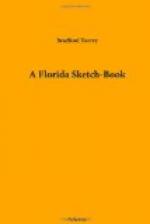I was no sooner in St. Augustine, of course, than my eyes were open for wild flowers. Perhaps I felt a little disappointed. Certainly the land was not ablaze with color. In the grass about the old fort fhere was plenty of the yellow oxalis and the creeping white houstonia; and from a crevice in the wall, out of reach, leaned a stalk of goldenrod in full bloom. The reader may smile, if he will, but this last flower was a surprise and a stumbling-block. A vernal goldenrod! Dr. Chapman’s Flora made no mention of such an anomaly. Sow thistles, too, looked strangely anachronistic. I had never thought of them as harbingers of springtime. The truth did not break upon me till a week or so afterward. Then, on the way to the beach at Daytona, where the pleasant peninsula road traverses a thick forest of short-leaved pines, every tree of which leans heavily inland at the same angle ("the leaning pines of Daytona,” I always said to myself, as I passed), I came upon some white beggar’s-ticks,—like daisies; and as I stopped to see what they were, I noticed the presence of ripe seeds. The plant had been in flower a long time. And then I laughed at my own dullness. It fairly deserved a medal. As if, even in Massachusetts, autumnal flowers—the groundsel, at least—did not sometimes persist in blossoming far into the winter! A day or two after this, I saw a mullein stalk still presenting arms, as it were (the mullein, always looks the soldier to me), with one bright flower. If I had found that in St. Augustine, I flatter myself I should have been less easily fooled.




